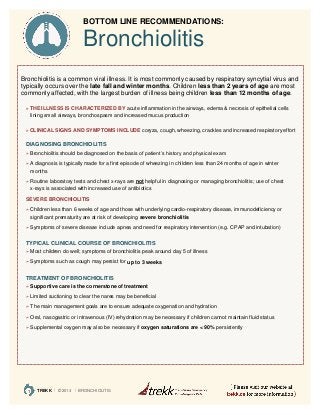More Related Content
More from meducationdotnet
More from meducationdotnet (20)
Cochrane - Bottom Line Summary of Recommendations in Bronchiolitis
- 1. Bronchiolitis is a common viral illness. It is most commonly caused by respiratory syncytial virus and
typically occurs over the late fall and winter months. Children less than 2 years of age are most
commonly affected, with the largest burden of illness being children less than 12 months of age.
» THE ILLNESS IS CHARACTERIZED BY acute inflammation in the airways, edema & necrosis of epithelial cells
lining small airways, bronchospasm and increased mucus production
» CLINICAL SIGNS AND SYMPTOMS INCLUDE coryza, cough, wheezing, crackles and increased respiratory effort
DIAGNOSING BRONCHIOLITIS
» Bronchiolitis should be diagnosed on the basis of patient’s history and physical exam
» A diagnosis is typically made for a first episode of wheezing in children less than 24 months of age in winter
months
» Routine laboratory tests and chest x-rays are not helpful in diagnosing or managing bronchiolitis; use of chest
x-rays is associated with increased use of antibiotics
SEVERE BRONCHIOLITIS
» Children less than 6 weeks of age and those with underlying cardio-respiratory disease, immunodeficiency or
significant prematurity are at risk of developing severe bronchiolitis
» Symptoms of severe disease include apnea and need for respiratory intervention (e.g. CPAP and intubation)
TYPICAL CLINICAL COURSE OF BRONCHIOLITIS
» Most children do well; symptoms of bronchiolitis peak around day 5 of illness
» Symptoms such as cough may persist for up to 3 weeks
TREATMENT OF BRONCHIOLITIS
» Supportive care is the cornerstone of treatment
» Limited suctioning to clear the nares may be beneficial
» The main management goals are to ensure adequate oxygenation and hydration
» Oral, nasogastric or intravenous (IV) rehydration may be necessary if children cannot maintain fluid status
» Supplemental oxygen may also be necessary if oxygen saturations are < 90% persistently
BOTTOM LINE RECOMMENDATIONS:
Bronchiolitis
1 TREKK | © 2014 | BRONCHIOLITIS
- 2. 2 TREKK | © 2014 | BRONCHIOLITIS
The purpose of this document is to provide health care professionals with key facts and recommendations for the diagnosis and treatment of
bronchiolitis in children in the emergency department. This summary was produced by the bronchiolitis content advisor for the TREKK Network, Dr. Amy
Plint of the Children's Hospital of Eastern Ontario, and uses the best available knowledge at the time of publication. However, healthcare professionals should
continue to use their own judgment and take into consideration context, resources and other relevant factors.The TREKK Network is not liable for any
damages, claims, liabilities, costs or obligations arising from the use of this document including loss or damages arising from any claims made by a third
party. The TREKK Network also assumes no responsibility or liability for changes made to this document without its consent.
This summary is based on:
1) American Academy of Pediatrics, Clinical Practice Guideline: The diagnosis, management and prevention of bronchiolitis, Pediatrics 134: e1474-e1502 (2014)
http://pediatrics.aappublications.org/content/134/5/e1474.full.pdf+html.
2) Hartling L, Fernandes RM, Bialy L, Milne A, Johnson D, Plint A, Klassen TP, Vandermeer B. Steroids and bronchodilators for acute bronchiolitis in the first two years
of life: Systematic review and meta-analysis. BMJ 342:d1714 (2011).
3) Bialy L et al. The Cochrane Library and the Treatment of Bronchiolitis in Children: An Overview of Reviews. Evidence-Based Child Health 6: 258-275 (2011).
© November 2014, TREKK; for review 2016.
MEDICATIONS FOR THE TREATMENT OF BRONCHIOLITIS
Note: The majority of evidence for treatment of bronchiolitis is for children < 12 months of age with a first episode of
wheezing in the winter months. The following recommendations are intended for this population.
THE FOLLOWING MEDICATIONS ARE NOT SHOWN TO BE EFFECTIVE IN EMERGENCY DEPARTMENT
TREATMENT OF BRONCHIOLITIS:
» DO NOT use salbutamol » DO NOT use oral bronchodilators
» DO NOT use ipatropium bromide » DO NOT use hypertonic saline
» DO NOT use inhaled corticosteroids » DO NOT use systematic corticosteroids on their own
» DO NOT use antibiotics
BRONCHODILATORS
» Limited evidence supports an observed trial of nebulized epinephrine for bronchiolitis
» If child shows improvement in respiratory status with epinephrine, further treatments may be tried
» If child does improve they should be observed for some time prior to discharge home
» Typical dosage is 3 ml of 1:1000 epinephrine or 0.5 ml of 2.25% racemic epinephrine in 3 ml normal saline
CORTICOSTEROIDS
» There is no evidence that oral or IV corticosteroids given alone reduce admission to hospital or improve symptoms
» There is limited evidence that dexamethasone and epinephrine given close together in timing may reduce
admission to hospital
CRITERIA FOR HOSPITAL ADMISSION
» Requirement for IV/NG fluids for hydration
» Requirement for supplemental oxygen
» Persistent respiratory distress
CONSIDER CLOSE OBSERVATION OR ADMISSION FOR:
» Infants <6 weeks of age or premature infants
» Infants with underlying cardio-respiratory disease or immunodeficiency
» Infants presenting with high heart rates and respiratory rates (heart rate >180 bpm,
respiratory rate > 80 bpm) even if they improve while observed in the emergency department
